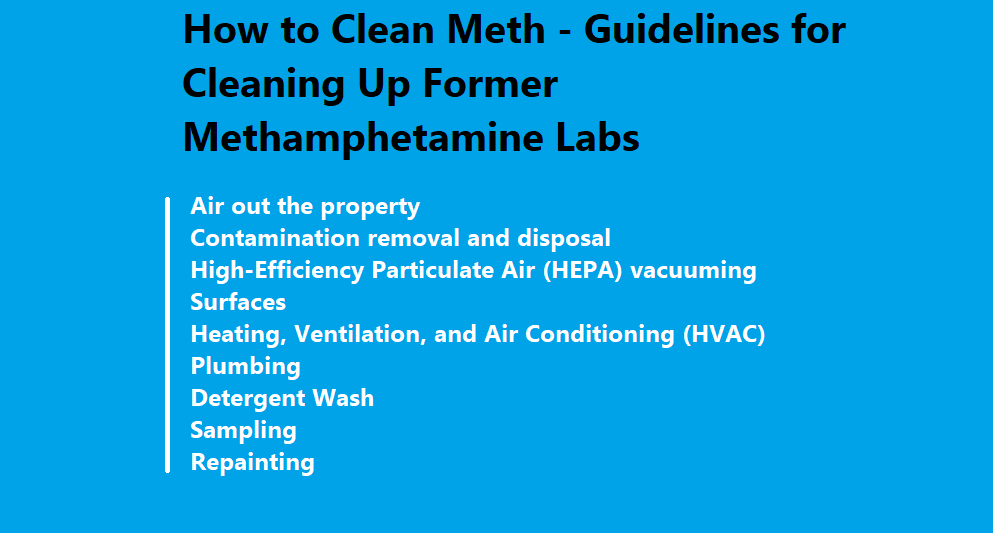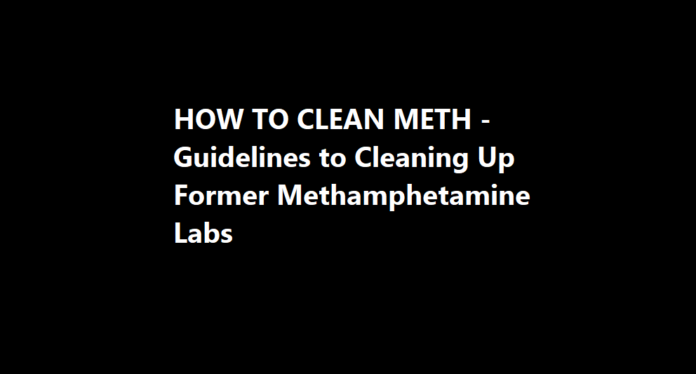To safely clean up a former meth lab, hiring a company specialized in handling hazardous waste and cleanup is best. Any individuals entering the property should be aware that all building materials and furniture may have absorbed contaminants and should take necessary precautions, such as wearing protective clothing and gear. Additionally, it is important to be aware of potential sanitation issues such as filth, pest infestations, and hazards from hypodermic needles.
In October 2009, the U.S. Environmental Protection Agency (USEPA) issued the Voluntary Guidelines for Methamphetamine Laboratory Cleanup, based on a thorough examination of the most up-to-date science and cleaning techniques. These guidelines should be used with the information provided in this fact sheet. A link to the USEPA guidelines can be found below.
Although there is no way to ensure complete safety, the procedures outlined in these documents offer the current best practices for minimizing exposure to the toxic chemicals used in meth production. Adhering to the cleanup procedures will help lower health risks by decreasing exposure to methamphetamine.
Scroll down to check out the guidelines for Methamphetamine laboratory cleanup:
How to Clean Meth – Guidelines for Cleaning Up Former Methamphetamine Labs

Air out the property
When law enforcement seizes a lab, professionals trained to handle hazardous materials typically come in to eliminate lab waste and bulk chemicals.
During this removal process, efforts should be made to ventilate the property for the safety of the removal team. However, more than this, short-term ventilation may be needed to remove all air contaminants.
It is important to ensure that the property has been ventilated for several days before cleaning and to maintain proper ventilation throughout the cleanup process.
Contamination removal and disposal
During meth production, fumes can spread and be absorbed by surrounding materials. Spilled chemicals, equipment, and supplies can further contaminate non-lab items.
These unnecessary and contaminated items should be removed from the property, made unusably, and disposed of in a local landfill as soon as possible to prevent reuse.
Absorbent materials such as carpets, drapes, and clothing can absorb fumes released during the cooking process and may also collect dust and powder from the chemicals used in the manufacturing process.
It is suggested that these materials should be properly disposed of, especially if there is an odor or stain present. Removing these items is more cost-effective than collecting samples and sending them to a laboratory for analysis.
High-Efficiency Particulate Air (HEPA) vacuuming
Before washing floors, walls, and other hard surfaces with a detergent and water solution, HEPA vacuum them to remove dirt, dust, and cobwebs after removing carpets and other items for disposal.
Surfaces
It is important to clean surfaces such as walls, floors, counters, and ceilings as they can absorb contamination from the meth cooking process. This is especially important in areas where cooking and preparation take place.
A thorough detergent wash of the walls and floors should be done to remove heavy contamination.
If a surface shows visible contamination or staining, it is recommended to replace it entirely, including appliances, plumbing fixtures, wallboard, floor coverings, and countertops.
Heating, Ventilation, and Air Conditioning (HVAC)
It is important to thoroughly clean and seal the HVAC system before running it again. This should be done after all other cleanup is completed.
Plumbing
During meth manufacturing, waste products are often disposed of by dumping down sinks, drains, and toilets. These products can accumulate in plumbing fixtures and septic systems, potentially producing strong chemical odors.
If you detect such an odor, it is recommended to contact a plumbing contractor. To prevent the spread of fumes, flush plumbing traps unless it is necessary to flush wastewater from the cleaning process through the system.
In that case, wait until all wastewater has been flushed before flushing the plumbing traps.
Detergent Wash
To thoroughly clean and remove contamination, use a solution of detergent and water to wash the ceilings, walls, floors, other surfaces, and non-porous furniture and items that will be kept.
After each wash, rinse the surfaces thoroughly with clean water and a rag. To ensure maximum effectiveness, frequently change the rag and detergent-water solution during the cleaning process.
Repeat the process of cleaning and rinsing a total of three times. Dispose of the cloth rags properly after cleaning is completed.
Sampling
Before conducting post-remediation sampling, ensure that the structure/items are completely dry. Sampling should be done before repainting.
Repainting
To provide a barrier between contamination and individuals who may come in contact with it, after cleaning an interior surface, it should be repainted using an oil-based paint, epoxy, or polyurethane primer, followed by another layer of paint. This will help prevent contamination exposure.
Where can I get more information?
Illinois Department of Public Health
Division of Environmental Health
525 W. Jefferson St.
Springfield, IL 62761
217-782-5830
TTY (hearing impaired use only) 800-547-0466
U.S. Environmental Protection Agency
http://www.epa.gov/oem/methlab.htm
How to Clean Meth? Residential Methamphetamine Lab Cleanup Checklist
- Call the police to ensure that a team dealing with dangerous materials has removed all chemicals and equipment used to make meth.
- Before, during, and after cleaning, make sure the house is well-ventilated.
- Wear special clothes and gear, like gloves, long sleeves, pants, sturdy shoes, a dust mask, and goggles, when cleaning.
- Throw away furniture, carpets, and other things that can’t be washed.
- Wash clothes and personal items that older children and adults use.
- Check all appliances, walls, and other things in the house for contamination and remove or replace them if needed.
- Vacuum the floors and walls with a special machine.
- Clean the floors and walls with a cleaning solution and water.
- Wait to use the heating, ventilation, and air conditioning system until the cleaning is done.
- Replace all the filters.
- Clean everything again with a cleaning solution and water.
- If you need to take samples, make sure everything is dry first.
- Repaint everything after cleaning.
- Leave the windows open for a few days after cleaning.
In October 2009, the U.S. Environmental Protection Agency (USEPA) released guidelines for the cleanup of methamphetamine laboratories based on a thorough review of the best available science and practices. These guidelines should be used with the information provided in this fact sheet. The link to the USEPA guidelines is available for reference.
Although no cleaning method can provide complete safety, the procedures described above are the current best practice for reducing exposure to the toxic chemicals used in manufacturing methamphetamine. Adhering to these cleanup procedures will help minimize health risks by decreasing exposure to meth.




